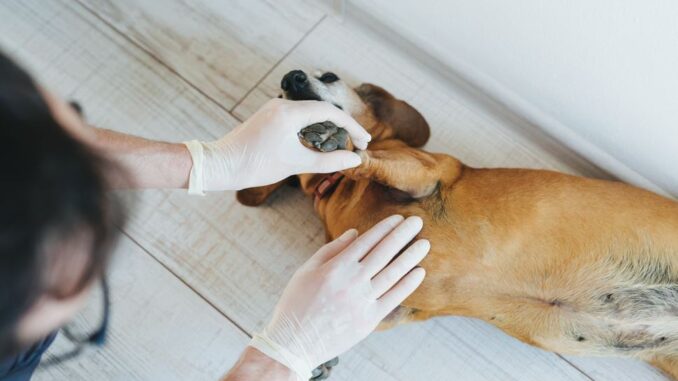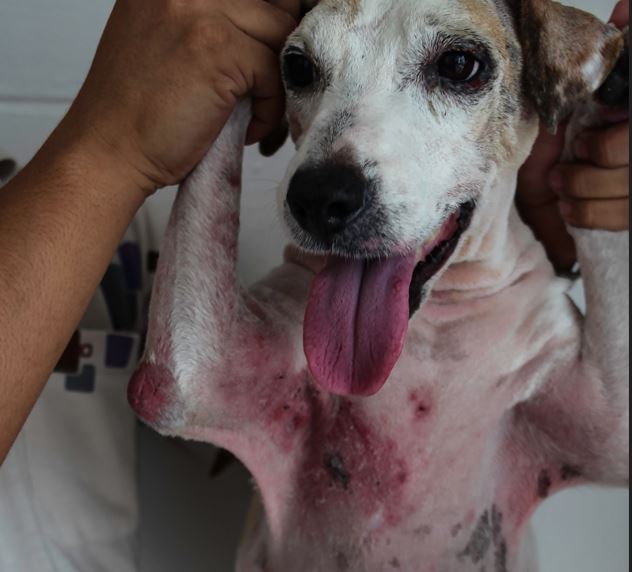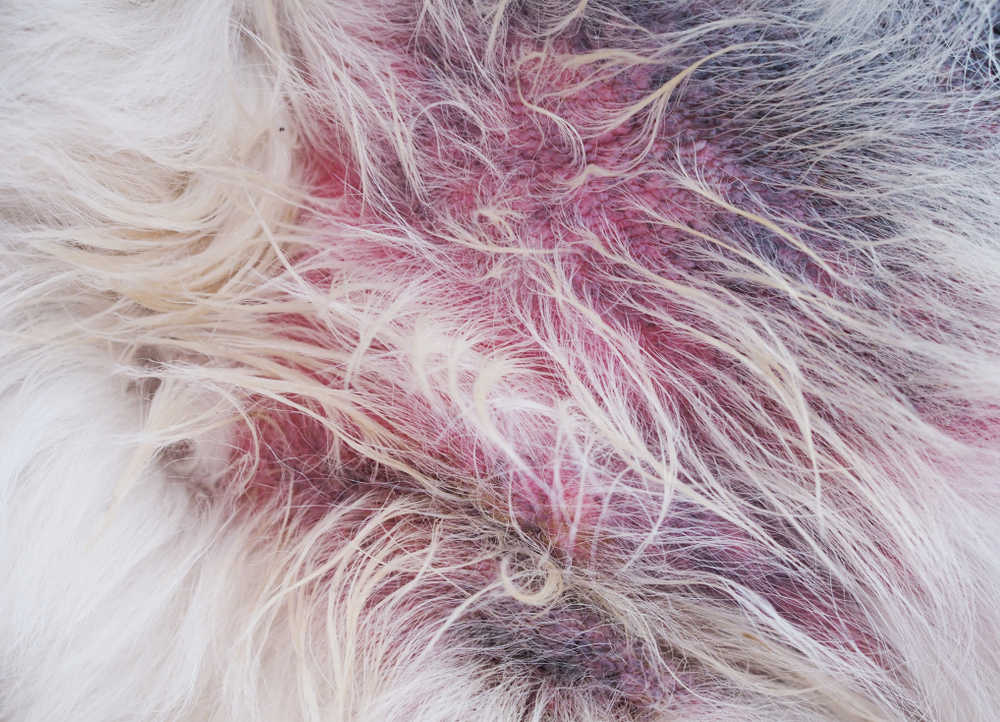
This article was updated on March 19th, 2024

Rashes are one of the most common skin issues we see in our pet clinic. They come in all shapes, sizes, and locations. Here, we’ll focus on one specific area: armpit rash on dog.
5 things you should know about armpit rashes on dogs
Dogs can experience armpit rashes for a myriad of reasons. Fortunately, most armpit rashes can be resolved with time, treatment, and appropriate medication. In this article, our veterinarian Dr. Chryle Bonk and vet tech Kate Howard share five important things about armpit rashes.
1. Armpit rashes can often be easily treated

Armpit rashes can be uncomfortable for your pet and concerning for you as an owner. However, with proper veterinary attention, they can often be easily treated.
In some cases, the rash might even go away by simply changing your dog’s harness, improving grooming or cleaning the area with warm water and a cloth. You’ll find our recommendations for home remedies later in this article, so keep reading!
In other cases, such as allergies or skin infections, prescription medication might be necessary.
Of course, the appropriate treatment will depend on the underlying cause of the rash, so let’s explore the most likely causes now to find out what might work for your dog.
2. Irritation, contact dermatitis, and allergies are among the top causes of armpit rash on dogs
A rash is present when the skin in this area is reddened, bumpy, or perhaps swollen. Rashes can also be itchy. The area may be moist or greasy if infection is present, or it may be dry and flaky if caused by a chemical, plant, or allergy. Top causes include:
1. Physical irritation (harness or clothes)
Especially when frequently wearing a harness or clothing, an armpit rash on dog skin is common. The simple solution is to discontinue the use of or exposure to the material, after which resolution should be quick. Dogs that are overweight and have excess skin rolls may have irritation rashes in the armpit from their skin rubbing together. Of course, the treatment is weight loss.
2. Allergies
Dogs can develop allergies to a variety of substances, including certain foods, environmental allergens, and flea bites. Allergies are increasingly common, though often mild, and can cause skin inflammation and itching, which can lead to a rash under the armpits or on the belly.

“The primary indicator that your dog’s armpit rash is due to allergies is if your dog is also itching. Dogs with allergies will often excessively scratch, lick, or chew the affected areas because it is so itchy.”
While allergies can’t be cured, and will affect your dog long term, management of a skin rash from allergies is possible with allergy and anti-inflammatory medications. Learn more about skin issues and allergies.
3. Contact dermatitis
While relatively rare, this skin reaction occurs when a dog comes into contact with an irritating substance, such as a chemical or plant (contact dermatitis can happen as a result of exposure to certain plants, grass, household cleaning products, fabrics, metals, or medications.)
You may be able to manage it by gently washing the area with warm water and a cloth. If it’s persistent or gets worse, your pet’s best chance at quick recovery may be a visit to their veterinarian.
4. Grooming/cleanliness issues
More common in longer-haired dogs than short-haired dogs (though not exclusive), rashes from matting or poor grooming practices occur when a dog’s fur becomes matted and tangled or there is trapped dirt and debris in the area. These contribute to skin friction or chafing that can lead to a rash and other issues. Proper grooming is great prevention.
“Removing the mat or cleaning the area could improve or even resolve the armpit rash within a couple of days or weeks. If a secondary infection is present, a visit to the vet is in order.”
5. Fungal or bacterial infections
These can occur when bacteria or fungi enter a dog’s skin through a cut, scratch, or other skin damage. Dogs with a skin infection may display red, inflamed or itchy skin, hair loss, and pustules or scabs in the affected area, as shown on the picture below. Quick recovery is likely with appropriate veterinary care. View more pictures of skin infections.

3. You can manage mild cases at home with over-the-counter products
While some armpit rashes require veterinary care, mild cases can potentially be managed at home with a few simple interventions. While you wait for a vet appointment, you can try the following:
1. Keep the area clean and dry
Clean the affected area with a gentle pet-safe cleanser and warm water, then pat it dry with a clean towel. This can help to prevent bacteria and fungi from multiplying and making the rash worse. This can also reduce physical irritants like dirt, debris, plant material, or allergens on the surface of the skin.
2. Apply a cool compress
After cleaning, apply a cool, damp cloth to the affected area.
3. Use a pet-safe anti-itch spray or cream
There are several over-the-counter anti-itch sprays and creams available for dogs that can help relieve itching and discomfort. Choose a product that is specifically formulated for dogs and follow the instructions carefully. Because ingestion of these topical medications can be hazardous, monitor closely and apply a “cone” (e-collar, Elizabethan collar) or other protective device to keep your dog from reaching the area while being treated.
Product Recommendation – spray:
- DOG HOT SPOT CARE: Spray a few times daily to relieve irritated skin that cause excessive scratching, chewing, and licking.
Product Recommendation – inflatable collar:
- COMFORTABLE FOR YOUR PET - While wearing the BENCMATE Collar, the inflatable function and the soft outside material will let your dog wear it comfortably and it does not block your pet’s vision, they can eat, drink, sleep and play at ease while staying protected.
4. Switch to a different type of harness or clothing
If you suspect the rash is caused by contact with a harness or other type of clothing, try a different material or style that doesn’t rub against the skin in the same way.
Product Recommendations – alternate harness:
- HELPS STOP PULLING: Patented Martingale loop design puts gradual pressure on your dog’s shoulders to safely and effectively stop pulling; a front leash attachment helps you guide your dog
- GREAT FOR ACTIVE DOGS: Best harness for running, walking and hiking with your active dog
These home interventions are only appropriate for mild cases that show signs of improvement with early intervention. If the rash is severe or doesn’t improve with home care, consult with your veterinarian for evaluation and treatment.
4. Look out for itching, swelling or other changes in your dog’s skin
With appropriate treatment and care, most dog owners note improvements and healing within a few days to a week. Closely monitor your dog’s rash and seek vet help if the armpit rash doesn’t improve.
You should contact your vet if:
– Your dog is displaying signs of discomfort or pain: for example, you may notice your dog scratching or licking at their armpit more than usual, or that they seem uncomfortable.
– Your dog is showing unusual changes in behavior.
– Your dog’s skin in the armpit area is warm to the touch, feels moist or greasy, or you observe any hair loss, swelling or scabs.
If you notice any of these symptoms in your dog, keep a close eye on the area and consult with your veterinarian if the symptoms don’t improve or if you notice any other concerning changes.
5. Some armpit rashes on dogs can be contagious
Non-contagious factors like allergies, poor grooming, and infections are among the most common causes of skin rashes. However, some rash-causing infections, like ringworm, can be contagious. If you’ve noticed an armpit rash on your dog, contact your vet to determine whether the rash could be contagious.
Frequently Asked Questions
How long does it take for an armpit rash on dogs to heal?
The healing time can vary depending on the cause and severity of the rash. Mild cases may clear up within a few days to a week with proper treatment and care. More severe cases could take several weeks or longer to heal. Closely monitor your dog’s rash and consult with your veterinarian if it doesn’t improve or if it gets worse.
Can an armpit rash be contagious?
Armpit rashes on dogs are often caused by a variety of non-contagious factors such as allergies, infections, or poor grooming. However, in rare cases, certain infections that cause skin rashes, such as ringworm, can be contagious. It’s always best to consult with your veterinarian to determine the cause of your dog’s rash and whether or not it is contagious.
Can armpit rash be a sign of a more serious condition?
While armpit rash on dogs is typically a mild condition that can be easily managed with proper treatment and care, it can sometimes be a sign of a more serious underlying condition. In some cases, armpit rash may be a symptom of an underlying allergy, autoimmune disease, or hormonal imbalance. Consult with your veterinarian if you notice concerning symptoms or if the rash doesn’t improve with treatment.
Disclaimer: This website's content is not a substitute for veterinary care. Always consult with your veterinarian for healthcare decisions. Read More.








Hello, I appreciate learning more about the rash under the armpit. I was wondering if cornstarch or possibly diaper rash medication would be safe to apply to the rash? Such as desinex. Thank you, Janet Henry
Hi there Janet,
I would personally not use either of these products. Some owners use cornstarch as it can help to dry out oozing and feels cool. Diaper rash medicine can contain zinc oxide which is toxic. I’d usually bathe the rash with either salt water or a dilute solution of Hibiscrub, however treatment really does depend on what exactly we are dealing with.
Dr Linda Simon MVB MRCVS
“The information on this website is not a substitute for in-person veterinary care. Always seek advice from your veterinarian if you have concerns about your pet’s medical condition.”